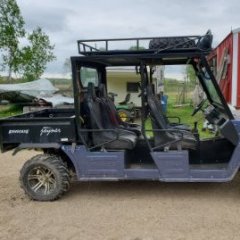2016 ODES DOMINATOR X4 wont start
-
Similar Topics
-
By Wolfpaak
I think this part is causing a high idle problem(4000 rpm at start up) in my 04 R4 Joyner. I took it out and cleaned it and the problem went away. I just went out to start my SXS and it's idle jumped up to 4 grand again. Can someone tell me what this part is called so I can search for a new one. Or can you point me towards a source.
Thanks in advance.
Kenny
-
By didgeridoo
Hello, All! I've decided to replace the traction batteries in my 2018 Sector E1 with a 48V Lithium set. They may be expensive, but I figure the Discovery Dry Cell are, too. I am not looking for the max driving range, as I have never received near the brochured range to begin with, but a good mix of charge/ get work done/ charge is what I am expecting.
I have settled on the 48V EAGL kit from bigbattery dot com. Each battery pack provides 30Ah. The kit ships with a charger, as well. The packs would be physically connected in parallel (using a busbar) to one another, maintaining the 48V voltage, but together would be able to provide the amp draw the buggy pulls when going up hill or towing a rake (rated 320 max continuous Amps). This is in comparison to the serial connection the eight 6V lead batteries. Each of the EAGL batteries looks to have its own BMS; am I correct in thinking I will have to use their included charger rather than (simply) changing the onboard charger to lithium mode? The chemistry of the pack is LiFe PO4, for what it's worth. I haven't torn anything apart yet (to diagram), so I am not sure how the dash will interpret the AMP draw, but the kit I am looking at includes a dash mounted charge indicator.
If anyone has completed a similar conversion, do you have any tips? Specifically, how did you remove the original batteries, and how did you secure the new ones? I am guessing that almost any change from the stock batteries would involve at least some modifications. Any tips would be appreciated, especially things I may have failed to consider. Thanks!
-
By Jon Spruill
Hey Guys, I have been chasing a stalling condition for about two weeks now. The bike will crank up and idle fine, then after about 20 seconds it will fall on its face and stall. It happens at both idle and while running at various rpms. You can turn the key off, turn it back on and it will fire right back up without trouble. I have verified spark on both cylinders with a spark tester. I have also added an inline fuel filter, and pulled the injectors to verify proper pulse on each. Things I have replaced - (relearn procedure performed after each component replaced): spark plugs, ECU, relay/fuse box, fuel pump, & throttle position sensor - all with no improvement of the condition. The only warning light I get when the condition occurs is the oil lamp. The bike only has 14 miles. I am at a loss and appreciate any help and suggestions! Thanks
-
By Hunterman22
2021 Hisun Axis 500 UTV (From Lowes)
Will NOT START
MY apologies if this is to much info just wanted to give yal the most information possible for help.
I'm a so called diyer. An Electrician by trade 21yrs. I got my S×S from my last job. The contractor purchased this S×S for this specific job brand new, from Lowes. They used it for hauling materials, tools, & a little bit of anything you can think of on an Industrial type job site.
I remember getting on the SxS one time & pushed the gas petal all the way to the floor & SxS had very little power.
So anyway ,when the job finished up back mid July this year (7/2024) , I asked the contractor what they was going to do with it. I was told to take it. Otherwise it would go to the contractors yard (storage yard) & most likely rust away.
Took it home washed it , it had a heavy coat of dust on it & in it dust was every where. My helper & I had to push it on the trailer to get it home. After washing it throughly I let it sit & dry out for a good day and half, maybe 2 days. Before trying to start it. NO START. Will turn over & try to start but thats it.
So here's what I've purchased & installed. New Air Filter, new spark plug, new air idle control valve (AICV), new throttle position sensor, new throttle body, new oxygen sensor, new digital dash speedometer/fuel gauge/clock.
Also drained the old oil & gas & replaced with new oil & 93oct. gas. I should probably mention that I've changed the AICV twice. The 1st time I changed the AICV I was able to get the SxS started & let idle for at least 10-15min. Drove out of the garage, with very little power, turned it around & barely got it back in the garage.That was the one & only time I've been able to start the SxS. I've also cleaned the Throttle Body and & intake with TB cleaner. So after that the AICV was making weird noise so I pulled it out & tried cleaning it, pretty sure I messed it up. So I purchased a Throttle Body that came with new AICV & TPS. Still NO START. I've checked the fuel pump & the fuel injector. I took the injector off still hooked up to wiring & turned the key over, the injector sprayed a lot of gas out kinda the size of a volleyball. I've also checked the clearance gap on the intake & exhaust valve. But today 11/2/2024 I'm going recheck spark plug gap & the valve gaps. And alot of other checking. Would the driver side seat belt have anything to do with it not starting?? I know the driver side seat belt has to be in gauged for full throttle "going fast". Thing is the drv. side seat belt will latch but feels like might be messed up inside of it. Tired opening it up but to no avail. I've never had a S×S or 4wheeler so I was really excited when I got the S×S,not so much anymore. I work on & fix my own vehicles usually no problems. But this SxS is kicking my ass.
So if possible & someone could help me with some ideas or tell me what Im doing wrong or did wrong, I would greatly appreciate it. Thank you for reading thus far.

-
By Marie
Hello, we recently got a 2013 Hisun 800 as a little project for my husband and I to work on. Turns out the guys before us loved the mud anyway. We have replaced the stator and now going to do the Rectifier but here is the hold up as seen in the picture. There are tons of wires going to the battery. I cant seem to find anything that shows what wires should, or shouldn't be attached to the battery or where these 2 plugs go. if someone would please take some pics or share knowledge to where they go I would appreciate it greatly.
-








Recommended Posts
Join the conversation
You can post now and register later. If you have an account, sign in now to post with your account.
Note: Your post will require moderator approval before it will be visible.